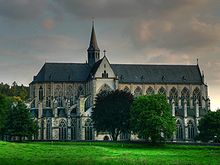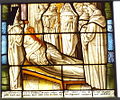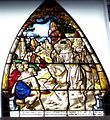Bernhard cycle from Altenberg Abbey
The Bernhard cycle of Altenberg Abbey was part of the 115 leaded glass windows in the former cloister of Altenberg Abbey . The glass paintings that were created around 1510 to 1530 in the course of the renovation of the cloister are only partially preserved and are in various museums.
Cloister of the Altenberg Abbey
The Altenberg cloister was built around 1220 to 1240. The stained glass cycles were incorporated around 1510-1530. In addition to the Bernhard cycle, there were also windows with Bible scenes, of which there is no trace. After the secularization of the monastery in 1803, the panes came into the possession of the monastery buyer, the wine merchant Johann Heinrich Pelpissen. He had the glass paintings expanded and bequeathed the collection to his daughter Maria Franziska, who was married to Wilhelm Schieffer in her first marriage and to Johann Baptist Hirn in her second marriage. Heinrich Schieffer, her son from her first marriage, inherited the stained glass and expanded his collection through further acquisitions. In 1824 some discs came into the possession of Matthias Joseph de Noël by auction , who gave them to the city of Cologne in 1852/53 along with other works of art. In 1932 they came to the Schnütgen Museum from the Kunstgewerbemuseum . Six discs came to the Mathias Chapel at Liebieg Castle in 1887 and to the Ludwig Collection in 1956. Still others were sold to England through the art trade in the 1920s.
Bernhard cycle
The Bernhard cycle comprised 97 stained glass in 1805, 44 of which are still in existence today. Of these, 18 are in the Church of St. Mary in Shrewsbury , 13 in the holdings of the Schnütgen Museum and 6 belong to the Ludwig Collection in Aachen. The Metropolitan Museum of Art in New York owns two discs , three are in Stolzenfels Castle and two in Altenberg (in the sacristy of Altenberg Cathedral ).
The cycle tells the life of St. Bernhard . They can be divided into the following subject groups:
- Bernhard's childhood and youth
- Beginning of the religious period
- Sickness and sick bed
- Beginning of the schism
- End of the papal schism
- Preparation for the Second Crusade
- Final acts and homecoming
- Symbolic representations
- Pin washers
Little is known about the donors of the stained glass windows. Only two discs with the representation of donors are still present today and only the donor Gottfried von der Ehren is known by name. The cycle is considered to be the most extensive cycle dedicated to Bernhard von Clairvaux.
Bernhard's temptation by the girl (detail)
See also
- Bernhard's temptation by the girl
- Bernhard visits Bishop Hugo of Grenoble
- Bernhard wins aristocratic tournament guests
literature
- Brigitte Lymant: The stained glass of the Schnütgen Museum . Schnütgen Museum, Cologne 1983.
- Dagmar Täube : Rhenish glass painting. Renaissance masterpieces. Vol. II catalog, Schnell and Steiner, Regensburg 2007, ISBN 978-3-7954-1944-8 .













